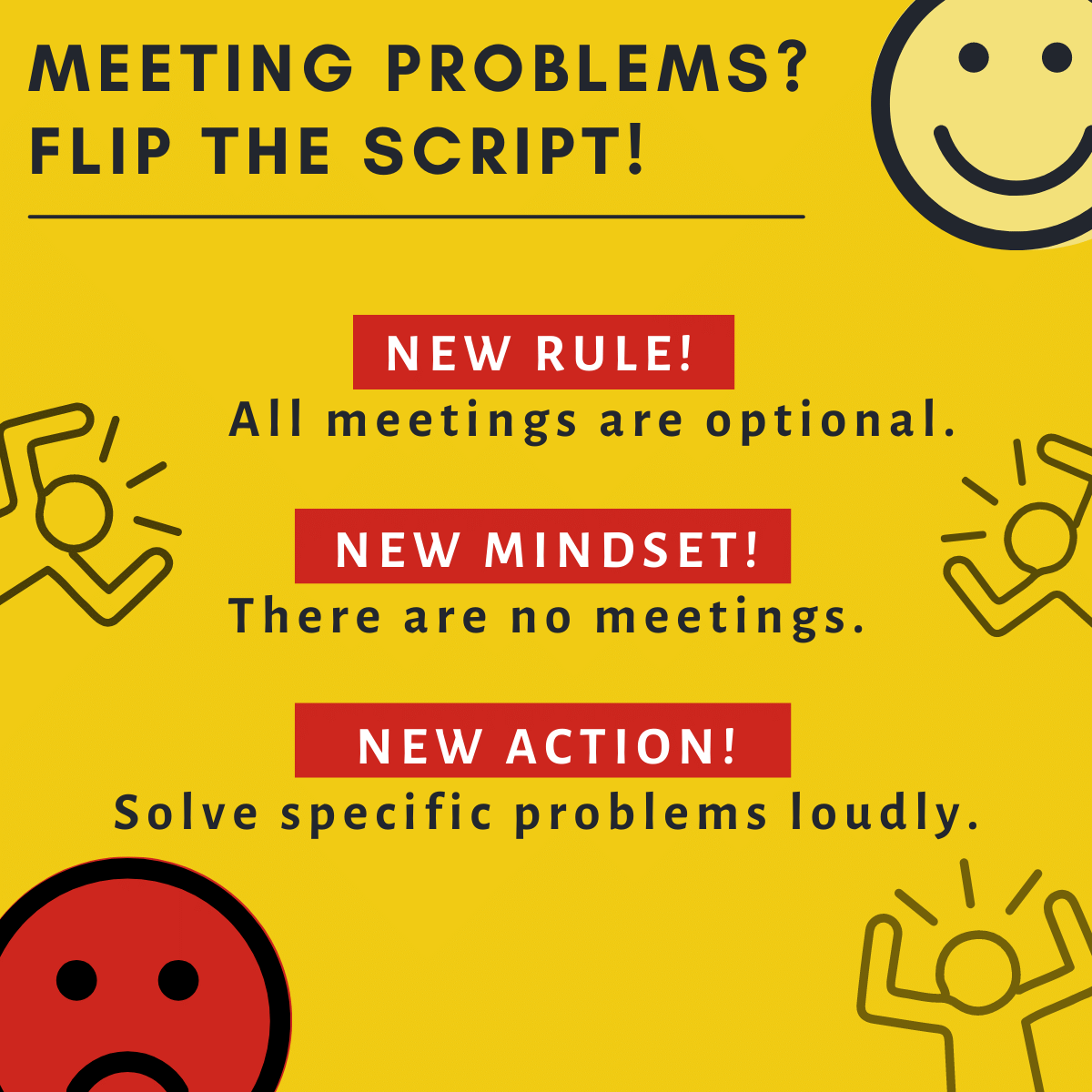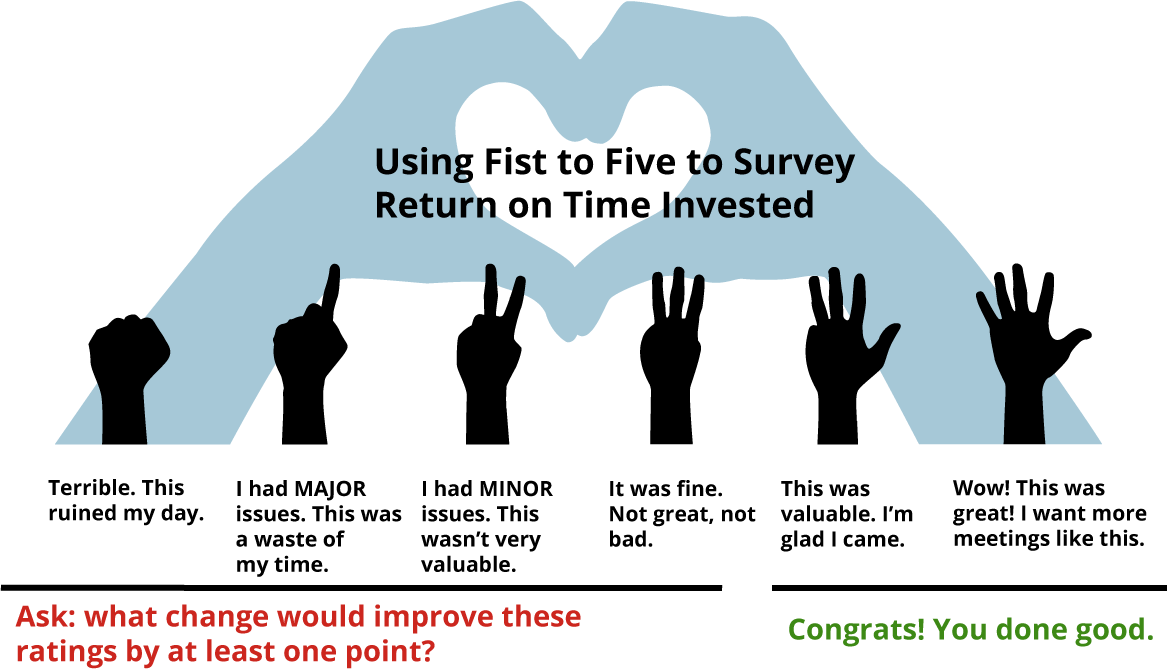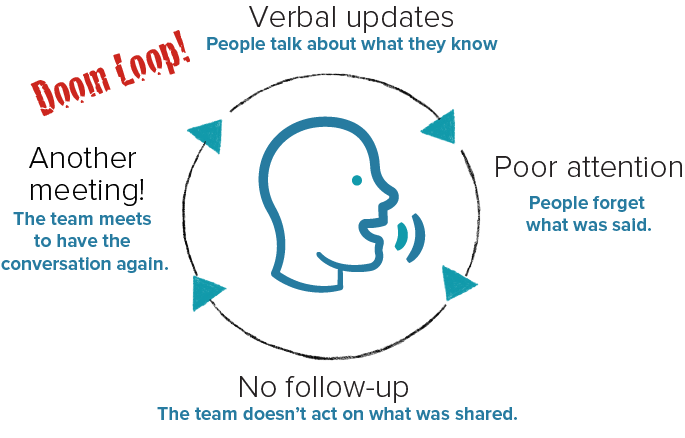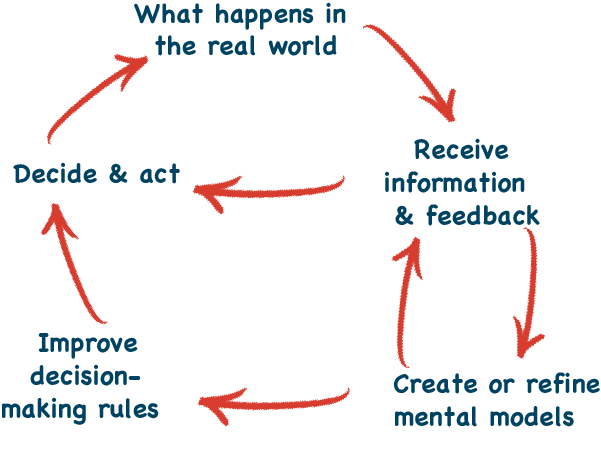Flip the Script on Meetings: 3 Ways to Transcend Your Team’s Limiting Beliefs
Do your employees complain about meetings? Have you tried introducing policies or technology to make meetings more effective, only to see bad habits and overloaded calendars quickly return? If so, your colleagues may be trapped by three common limiting beliefs – mental barriers that keep them from realizing the true potential of well-coordinated gatherings.
They may believe that:
- Meetings suck. All efforts at improvement are doomed.
- Not my place. Only “leaders” have the authority (and responsibility) to improve meetings. I don’t want to rock the boat.
- It can’t be done. It’s not possible for meetings to work well across an entire organization.
It’s incredibly difficult to inspire positive results when you start with a negative belief. This challenge holds true for each of us individually and is magnified when a limiting belief is shared by a group.
In this article, we will explore three strategies to break through these harmful meeting myths.
Don’t Bother Trying to Convince People
Sadly, it rarely works to tackle these crippling convictions head-on. Logical arguments about the necessity of meetings and how they can be super fun and interesting and productive haven’t worked for the last 150+ years, so they’re unlikely to work for you now.
Instead, I recommend coming at these beliefs from another angle. Take action and reframe the conversation.

These strategies focus on each person’s autonomy to make productive choices and the group’s opportunity to design how they work.
| Belief | Root Causes | Myth Buster |
|---|---|---|
| Meetings suck. | Time spent in meetings with an unclear purpose, no ability to participate, and/or weak results. | 1. Meetings are optional. 2. There are no meetings. |
| Not my place. | Meetings are always led by the same people. No one else speaks up during meetings. Leaders seem uninterested in change. |
3. Solve specific problems loudly. |
| It can’t be done. |
No experience of success. |
See 1-3. Then, design your Meeting Operating System. |
New Rule: All meetings are optional.
This rule eliminates excuses for wasting time, forces leaders to clarify the value of meetings, and supports core values. By implementing a policy that all meetings are optional, employees are responsible for using their time well, and leaders must offer valuable meeting experiences to ensure attendance.
And in case you’re wondering, companies really do adopt this policy. You can hear leaders talk about how this works for them in this NYTimes article and Chris Dyer’s presentation
It sounds like a radical policy, but when you look more closely, you’ll see that it’s a no-brainer. Here’s why.
Making meetings optional eliminates excuses.
No one likes their time wasted in a pointless meeting. We also hate sitting next to someone who’s checking their email, rolling their eyes, and vampire-sucking all the energy out of the room.
The reality is we are all adults, and no one can force you to attend a meeting you believe to be a waste of time. Most meetings are already optional, but it sure doesn’t feel that way.
By creating an explicit company policy stating all meetings are optional, you eliminate the excuses. There’s no longer any excuse to sit in a meeting doing other work. If that work is more important than the meeting, go do it! The policy makes it clear that each person is responsible for using their time well.

Meeting leaders lose their excuses for holding lousy meetings, too. How?
Making meetings optional forces leaders to get clear on the value.
When no one has to attend your meeting, and when anyone can leave if they realize it’s not a good use of their time, meeting leaders must learn to advertise the value of each meeting in the invitation. A policy of optional meetings forces leaders to think critically about why the meeting’s needed, who would get value out of participating, and what the results should be.
This clarity is required for any decent meeting, but busy leaders often skip this work when they know folks will show up anyway. Remove the assumption that other people will participate in a lousy meeting and you remove many of the lousy meetings.
Making meetings optional reinforces your core values.
For example, in our company, we value excellent service and well-being. Because our meetings are all optional, our team knows that they’re expected to help our customers and take care of themselves first — even if it means arriving late or missing a meeting altogether.
By making meetings optional, organizations make it clear that meeting isn’t the point. This policy tells employees that if it’s a choice between living your values or a meeting, you want values to win every time.
Making meetings optional makes meeting performance integral to job performance.
An optional meetings policy does not imply that meetings have no value. On the contrary, meetings are one of the most powerful tools we have for setting direction, creating alignment, solving problems, and driving momentum.
Instead, this policy makes every individual responsible for making meeting time worthwhile. If leaders fail to run valuable meetings, and their teams opt-out, that will absolutely impact performance. If a team member decides to opt out of all meetings, thereby failing to contribute ideas, solutions, and information to the group, then their value to the organization decreases dramatically.
Both kinds of performance failure are common in companies without this policy. Leaders regularly fail to make meetings valuable and employees regularly fail to contribute, but we accept this because we assume “meetings suck.” Poppycock!
When you make meetings optional, you now have a clear way to talk about and expect performance that creates value from everyone. No excuses!
Making meetings optional encourages excellent record-keeping.
Recently I worked with a company struggling to balance their desire to be inclusive (which encouraged everyone to come to every meeting) with their need for productive meetings.
The leaders desperately wanted more focused meetings so they could get decisions made, but they didn’t want to turn anyone away. Employees wanted to stay informed but felt frustrated when they found themselves in meetings that didn’t impact their work and where they couldn’t participate.
Oh no FOMO! The fear that if you don’t attend a meeting, you’ll be left out is yet another limiting belief that traps people in bad meetings.
Making meetings explicitly optional was the first step in changing this culture. That let employees who felt obligated to attend meetings off the hook.
The second step was making sure every meeting had a clearly stated purpose in advance, so people could see which ones were directly relevant to them.
Then, most critically, notes were published for every meeting so everyone could see the key points, decisions made, and next steps. For those of you adopting AI-driven meeting summaries, you can automate much of this work.
It took time, but it worked. Everyone in the company can now see in advance which meetings matter to them and choose to only attend those where they have an active role to play. And, knowing they’ll see the notes afterward, people can skip meetings and still stay informed.
Making meetings optional means you’ll get smaller, better meetings. And fewer of them.
Put it all together and organizations get a dramatic impact from this simple policy. As with any new policy, leaders must repeat it many times and opt out of meetings themselves before others believe. Once your team sees you model this policy in practice, however, expect to see rapid change.
As a business leader, I know that by making meetings optional, we’re making it easier for our employees to make good choices about when and how they meet. Any policy that results in smaller meetings, better meetings, and fewer of them is not provocative. It’s good business.
Tips for Rolling Out a “Meetings Are Optional” Policy
Your top executive should announce this policy. They must make it loud and clear that all meetings are optional.

Guidance and Safeguards
To make it easier for people to embrace their new power, provide guidance and safeguards. For example, you might state that:
- You are expected to apply judgment and take responsibility. Opt out of any meeting that isn’t a good use of your time.
- ALWAYS RSVP. When opting out, share your reason. This shows respect for others and prevents bad assumptions and resentment. For example, you may choose to opt-out because:
- You have an urgent deadline and must stay focused.
- You aren’t clear on what the meeting is about or how you’re meant to contribute.
- You have nothing to add and can review the notes later.
- You can share information outside of the meeting and have no need to collaborate.
- Another person from your group will represent you at the meeting.
- You’re sick, on a plane, having a baby, or otherwise blindsided by life.
- No retribution! Managers and meeting leaders may not penalize anyone for opting out of meetings.
New Mindset: There are no meetings!
Yes, I’m suggesting you define away the problem, but bear with me here.
People complain about MEETINGS. Meeting fatigue, too many meetings, back-to-back meetings… and you can’t do a damn thing with that. It’s too complex, too generic, and too deeply ingrained as a fundamental truth. Everyone knows that meetings suck, right? You aren’t going to win this one by taking it head-on.
Still, people try all the time. No meetings longer than 50 minutes! Everyone has to stand up! No agenda, no attenda! These ideas aren’t entirely terrible, but there are too many exceptions. They just don’t apply to all meetings.
This makes enforcing generic meeting rules feel like trying to eat ramen with a butter knife. You might catch some of them, but mostly it’s just frustrating and messy.

So – rather than try to force-fit a power suit onto your Jabba-the-Hut-shaped problem – eliminate the word “meeting” from how you’re investing your group’s time.
Don’t talk about meetings at all. Don’t schedule meetings. Don’t make excuses about needing to leave a meeting because you have another meeting. That word is not serving you.
I picked this idea up when studying great team cultures. The groups that do it best rarely have anything on their calendars called a meeting. Instead, they have Huddles, Strategy Days, Adrenaline Calls, Peer Councils, Braintrusts, Hot Washes, Executive Briefings, Scrums, Bullpens, Kickoffs… lots of well-defined opportunities for people to collaborate in real-time.
To get started, ensure everything on your calendar is clearly named.
These names can reflect either a known event type (see the examples above) OR the purpose for the gathering. They may NOT include the word “meeting” or any of its synonyms.
See ideas for implementing this practice here:
Want Better Meetings? Put the Purpose in the Name
Then, any time someone complains about meetings, ask: Which events are you talking about specifically? Can you give me an example? This is much easier to do when all your gatherings have clear, meaningful names.
This leads to strategy 3.
New Action: Solve specific problems loudly.
Limiting beliefs are a lot like stereotypes. They sow the fear, doubt, and distrust that keeps folks locked in downward spirals.
And they’re usually based on a grain of truth.
In the case of meetings, the negative stereotypes are based on sandy beaches full of grainy examples. People complain about meetings because they experience unproductive meetings and never see anyone taking action.
So – to shift that belief, people need direct experiences that contradict it. They need to experience beneficial meetings and NOTICE that they’re having that experience. They need to experience unproductive meetings and hear people speak up to change them.
How do you make it clear and obvious that meetings can be improved?
Ask more questions to get better answers.
If you work in People & Culture, Training, or Operations and you’re fielding complaints about meetings, ask: –
-
What do you mean specifically? What’s an example?
-
Tell me about a time when you experienced this – what happened?
-
What support do you need?
Are you a meeting leader? If so, you’ll likely think you’re doing okey-dokey unless someone tells you otherwise.
Folks will not tell you what they really think unless you ask.
So ask! For example, try asking:
- Here’s my plan for the meeting. What’s wrong with this? What am I missing?
- Would someone like to lead this meeting? Who can lead the next one?
(It shouldn’t be you all the time! Rotating roles is awesome.)
Are you part of a team that didn’t ask for bad meetings, but has had bad meetings thrust upon them?
Ask your leaders:
- Can you help me understand how to be most productive here?
- I’m noticing that our meeting (fill in the blank) and I’m concerned about (time/productivity/energy). I’m wondering if we can try something that might help?
Get ’em while they’re hot! Collect recommendations in the meeting.
If you’re trying to improve your meetings, you need a way to see if you’re making progress. Save three minutes for collecting feedback. This shows you how you’re doing, reminds everyone that you’re working to improve, and surfaces specific recommendations.
I like the ROTI technique for this. It’s super fast and results in specific improvement ideas.
Share success stories.
Stories sell.
In this same NY Times article, one leader shares a story about how standing up through a candidate interview resulted in a highly productive meeting and a glowing first impression. Hired!
Get even more exquisitely specific.
Specific meeting problems are solvable in ways that the generic “meetings suck” problem is not.
When someone complains about the daily Scrum, for example, you can work on that. Totally doable. You know what a Scrum is, you can research nifty Scrum techniques, and then fine-tune your practice.
When someone complains that even though they enjoy their meetings, they’re struggling to find focus time, you can shift the schedule. Engineering teams can send a delegate to some calls. IT may host regular support hours, rather than accept ad-hoc meeting requests. You can block out certain days or hours for focus time. There are lots of ways to optimize schedules.
Finally, getting specific may reveal that a “meeting problem” is actually a relationship problem. It’s not meetings that they hate. It’s meetings with angry Frieda who should have retired 10 years ago but instead insists on holding her team captive for a daily haranguing.
When the real problem is angry Frieda, making all meetings 10 minutes shorter isn’t going to do the trick.
To illustrate how important it is to get specific when you’re seeking advice you can actually use – instead of asking as a way to make it look like you care – let’s ask ChatGPT for help with these meeting challenges.
Your turn! Bust up that status quo!
Meetings are not inherently a waste of time or a source of frustration for employees. Every one of them is what we make it to be. Why settle for mediocrity when so many easy fixes are within reach?
By identifying and breaking through the common limiting beliefs that hold people back from productive meetings, organizations can design meetings that deliver.
Get started today by reframing the conversation.
- Make every meeting optional.
- Even better, get specific about what each one is called and how it works. There are no “meetings.”
- Then, unleash radical curiosity on anyone who complains, anything that feels off, and any ideas people have for doing better. Ask questions; share stories. Solve specific problems loudly.
Stop trying to convince people with logical arguments, and take action. Reframe the conversation to transform meetings into opportunities for growth.




